I was last at L'Enclume in August 2013, and since then they had been crowned the best restaurant in the United Kingdom by the Good Food Guide and it had been announced that Simon Rogan would be taking on the restaurant in Claridges in London. Nothing ever stands still at L'Enclume, even less so for Simon Rogan himself.
On this visit, in the middle of November 2013, the changing seasons meant much of the menu had changed: some dishes were subtly different; some were entirely new.
This, and a brief chat with Simon Rogan about his plans for the Claridges restaurant, got me thinking on the way home about all the changes that I've seen at L'Enclume, and, after the quickest bit of maths, I realised that I'd been going to L'Enclume for ten years, my first visit being just a few months after it opened in 2002.
It would be far too long a post to run through all the changes that those ten years have seen, but before going on to my November 2013 meal, I thought it might be interesting to revisit my first report of L'Enclume, written in June 2003. There are no photographs from back then, which partly explains the vagueness of some of the descriptions.
| L'Enclume was undoubtedly the north of England opening in 2003. Getting the non-food stuff out of the way first: the setting is quite splendid. A converted smithy (hence the name: French for "anvil"), with cooling whitewashed walls. White table cloths, good cutlery, good glasses. Even the lighting is good. A conservatory for aperitifs that's not too conservatory-like and a lovely garden with a stream running past, all nestling below Cartmel Priory. On a warm day, it's very difficult not to linger - even to the point of having a cafetière rather than an espresso after the meal. Cartmel is not exactly a busy metropolis, but L'Enclume and particularly its garden provide a complete oasis from the outside world. I have been several times now, and the standard of cooking has been consistently high and innovative. First impressions of the menu are of a Blumenthal/Fat Duck type striving for effect. But while Blumenthal is more about technique, Enclume is about tastes and textures with Marc Veyrat overtones, underpinned by a strong classical technique. Particularly looking at the menu, but also at the food when it arrives on the plate, it is easy to get the impression that there is a striving for effect. That may well be - and I suppose in the crowded market of the Lake District you perhaps need a USP - but the key is that it all works, and often better than it sounds. Menu descriptions tend to the listing every ingredient in a dish variety, which can make you slightly nervous when it comes to something like a "calamint, bark and blossom infusion", but the weirder sounding stuff stands out as weird far more on the page than it does on the plate. Unusually for a Lake District kitchen, there is no sticky toffee pudding (thank goodness) - anyone with withdrawal symptoms can pick up the famous (but not that good, in my view), Rick Stein Food Hero version, from the village shop just down the road. There are, I believe, 5 menus - a TDH at about £20, the à la carte, and three "Taste and Texture" menus: a seven course "Introduction" at £50; a twelve course "Intermediate" at £75 and a 19 course "gourmand" menu at £95. With the carte at least come the freebie appetisers and pre-desserts. The wine list is very well chosen. I have been for lunch on several occasions, and so far always opted for the carte. The first time was a standard 3 course affair that I now can't remember in its entirety. A dish of turbot and oxtail gayette was quite superb: not at all surf and turf - all elements were perfectly executed and worked harmoniously. This was followed by a Monkfish 'cinq saveurs' that I can't remember much more about than a spicy crust and enjoying enormously. My companion's starter was a "foie gras hors d'oeuvres", comprising I think 4 little foie gras goodies - terrine, pate, fried and a Marc Meneau style cromesqui. Personally I think the foie gras cromesquis, which seem to be becoming more common, are better as a tie-ruining (for the uninitiated) appetiser, than as a substantive element of a dish. One visit was on 5th June 2003 - a gorgeous boiling hot day, with the sun beating down, while the ducks played amorously in the stream. Indoors was cool, pleasant and welcoming. So I sat outside in the sun (!) with a glass of very good citron pressé (which had to be made in the kitchen for some reason) while I read the menu. Rather than a starter-main course meal, I chose three starters, and asked for a glass of appropriate wine with each. It is a mark of the high standard of the staff that they are unphased by such requests (and indeed hadn't responded "yer wot?" to the request for a citron pressé). Things got underway with a slab of slate bearing three "freebie" appetisers: A shot glass of superb asparagus velouté - quite excellent - beautiful colour and an excellent intense flavour. Dauphinoise potato with leek - not so good. A bit underseasoned and undercooked. I like the cream for my dauphinoise to have been cooked for a while. This was like a warm vichyssoise before processing. Which now I write that, I realise was exactly what it was! The description was wrong, maybe. Last of the appetisers was a red pepper bavarois. Again in a shot glass. A quite exquisite texture and hugely intense flavour. Superb. Excellent bread, including a saffron bread, and a sea lettuce bread among about 5 varieties with Echiré butter. My first course was a sweet woodruff jelly, pickled cucumber, flaky crab, oscietra caviar and "nearly-caramelised baby squid." Each element was superb in itself. Sweet woodruff has a refreshing taste all of its own (and is representative of a number of less common herbs that appear on the menu - maybe chef Simon Rogan is a bit of a forager?), the pickled cucumber was 'spaghetti'd' and slightly sweet, slightly sour , the flaky crab was very fresh tasting white meat that had somehow been fluffed up (you might even imagine that each 'grain' had been separated by hand) and then loosely formed into a neat quenelle. The squid was excellent - tiniest squid imaginable and, as the tin said, nearly caramelised. Everything on its own was quite perfect, but the combination of tastes and textures was simply exquisite. The only drawback might have been that the third of a coffee spoon of oscietra was not quite enough to stretch beyond more than two mouthful combinations (if you see what I mean). They selected a glass of Mosel Riesling Kabinett to go with this, which it did - rather well in fact. Next up was a nage of langoustines with green vegetables (i.e. peas, beans and broad beans) cooked in a calamint, bark and blossom infusion. Quite exceptional langoustines, perfectly cooked. Stunning colours and flavours on the plate. Presentation of all the dishes is very good indeed. This was matched well by a glass of good, if rather warm muscadet. Third came Lozenges of quail, roast ramsons (bit late in the season for ramsons, isn't it?), bergamot salsa and a smoked papaya vinaigrette. Another splendid dish, again each component well done (though I'd not have guessed at smoked papaya in the sauce if it had been served blind) and the whole managing to be greater than the sum of its parts. I find it very interesting the way that all components of a dish are excellent in themselves, and thoroughly enjoyable on their own, but when you put it all together on the fork it takes it to a different level. There is a very assured hand at work in the kitchen. The quail breasts were perfectly cooked and served on the finest of finely chopped brunoise of apple and carrot - certainly no more than a sixteenth of an inch perfect cubes. I have to pity the poor person who'd chopped them. A glass of surprisingly good chardonnay from the Veneto came with this, again a touch on the warm side unfortunately. Then there were the pre-desserts, which I have forgotten entirely, though I'm pretty sure shot glasses came into it again. Dessert proper was an upside down coconut soufflé with roast pineapple and a mango chutney ice-cream. The plate arrived, bereft of any sign of souffle, but with a palm tree painstakingly constructed of tuile biscuits glued together with caramel and a slice of highly spiced roast pineapple topped with the equally heavily flavoured mango chutney ice-cream. Seconds later a teacup containing a souffle appeared and was ceremoniously up-ended onto my plate. Well, yes, it was now an upside down souffle. The coconut souffle itself was - I'm sorry, I'm going to use the e word again - excellent. No trace of egginess, no trace of the dreaded dessicated coconut, but just an elegantly perfumed textbook souffle. Excellent. I have to say I found the mango chutney ice cream a little on the overpowering side. As if you might not have had enough puddings, coffee comes with a shot glass of very good, spongeless tiramisu and a chocolate filled doughnut. The only weak points in the whole meal were the over-flavoured mango chutney ice-cream and the chocolate donut petit four, which was a little chewy. Everything else was characterised by the innovation of the combinations, the use of unfamiliar ingredients and the intense, very clean flavours. I have no reservation in saying that this should get a very very high 8/10. Properly chilled wines by the glass, a little more flavour and seasoning in the vichyssoise cum dauphinoise pre-starter and a milder mango chutney ice-cream would make it an easy 9/10. I really hope L'Enclume proves a commercial success, as it is a much needed injection of style and skill into the North Lancashire dining scene. (Any Lancastrian will tell you that Cartmel really is part of Lancashire, whatever the 1974 boundary changes said ...) |
It's interesting to reflect on what's changed, and what hasn't. Behind the scenes, the kitchen has just this year been extended and completely refitted. and Simon Rogan has taken over what was the adjacent post office and turned it into his development kitchen, Aulis (itself still be refitted at the time of this visit). The garden has reduced in size considerably, yielding to an extended conservatory that has more than doubled in size and now has the best tables in the dining room. It's still one of my favourite dining rooms in the country, and there's still the same relaxed feel, helped by well-orchestrated staff who make everyone feel at ease.
The big change has been in the food. Rogan has, after a few not-quite-false starts in the earlier years, now found his own style and niche. That's not to say there aren't occasional influences from elsewhere. Some might even be unconscious. As is evident from my 2003 report, there were already marks of the now well-known Rogan style from the beginning, with things like calamint and sweet woodruff taking the limelight. What is dramatically different in the 2003 report, however, is the presence of things like foie gras, oscietra caviar, papaya, pineapple, mango etc. Now all the ingredients at L'Enclume come from the British Isles, and indeed increasingly the majority come from Simon Rogan's own farm down the road from Cartmel, which supplies all his restaurants and continues to expand to meet that demand.
The menu structure is much simpler now: in the evening there is just one menu, with 20-22 courses, while at lunchtime there is the same tasting menu, plus a shorter 6-course menu. The prices make an interesting comparison. In 2003, a 7-course menu was £50, while today the 6-course lunch is just £45. In 2003 the 19 course "gourmand" menu was £95: today the main tasting menu is £120 for 22 courses. (Though it's worth noting that "courses" is a generous description, for today it includes a number of small appetiser tastes.) Looking at an online inflation calculator, I see that 2003's £95 would today be £127.22. So (please look away now, Simon Rogan or anyone employed by him!), if anything, the price of the main tasting menu has gone down. And they have two Michelin stars and have been accorded the title of best restaurant in the UK now. £120 is a hell of a lot of money for lunch, but I would argue that it is impossible to argue that it's not great value.
You can spend £53 to watch Manchester United play for 90 minutes. The £120 menu at L'Enclume will take four hours of your time, and you get fed too. For £125 you can get to drive a Ferrari for four laps round a race circuit. At the time of writing, it could cost you between £198 and £230 to get a seat at the Royal Opera House to watch Parsifal on 2nd December 2013. If I needed to get a train to London tomorrow, it'd cost me nearly £160 to be there by 10am.
So, what do you get for £120 at L'Enclume? Beyond enjoying the experience and the setting and using their heating and lighting for four hours, that is.
First to come out of the kitchen, after they've checked for allergies, dislikes or just plain faddishness, are a series of small one-bite appetisers/canapés or whatever you want to call them, each of which counts as a course in the total 22.
There are some standard, unchanging items on the menu now, Rogan signatures I suppose, and the first thing to come out is one of them: oyster pebbles.
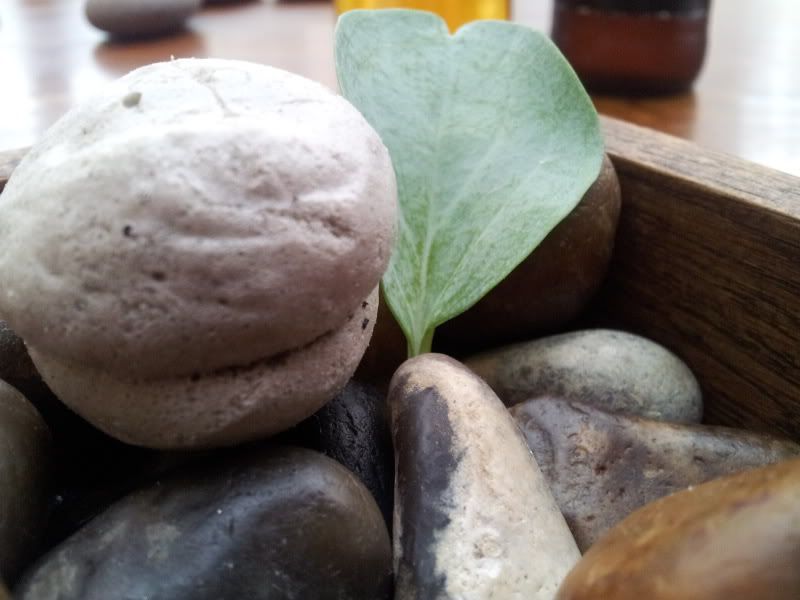 |
| Oyster pebble with oyster leaf |
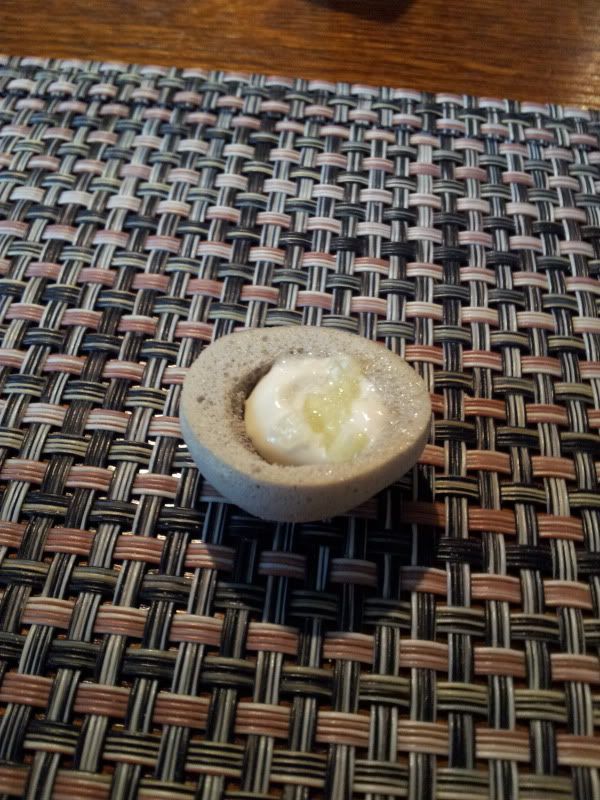 |
| Interior of the oyster pebble |
Next came a new dish for me, described on the menu as radish and blackberry, but between the menu being printed for me and it coming out of the kitchen, the blackberry element had turned into a horseradish cream.
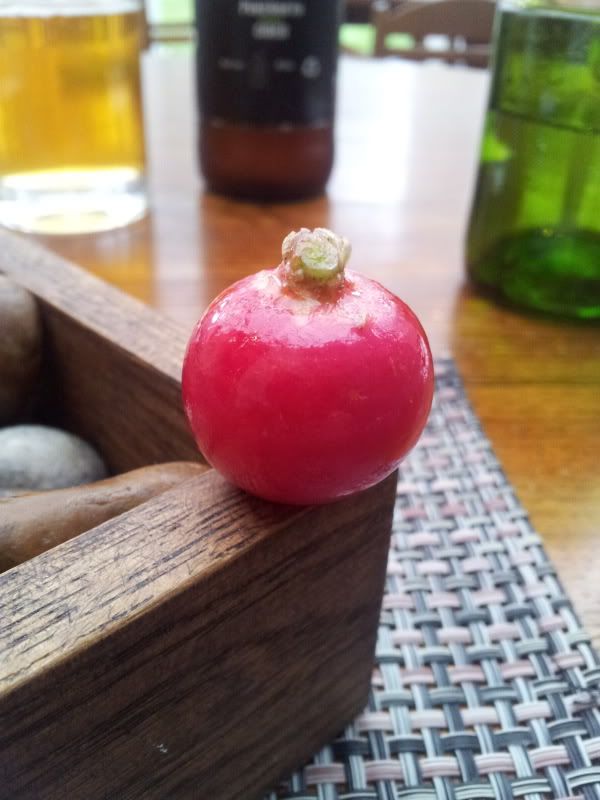 |
| Radish and horseradish |
The next three dishes came together.
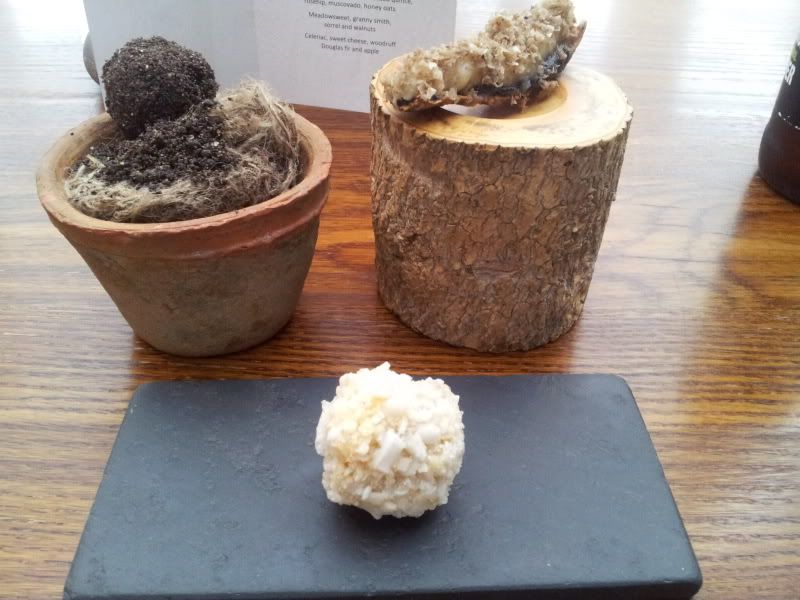 |
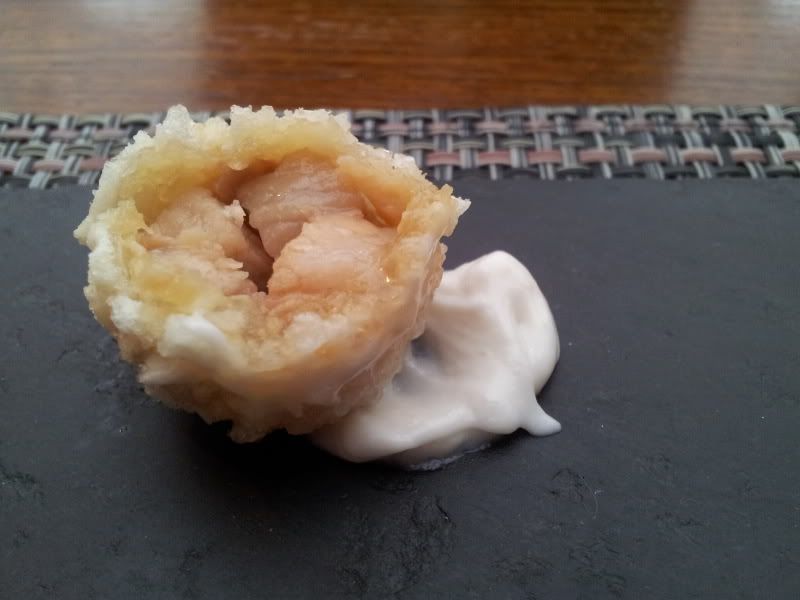 |
| Interior of the smoked eel with ham fat |
The final element of this trio was a riff on a common combination of flavours at L'Enclume: Jerusalem artichoke and truffle.
 |
| Artichoke with truffle |
We're still in the appetiser section of the menu, but now the portions start becoming slightly larger. The next dish was another new one for me: a truly beautiful looking scallop tartare, presented in a queenie shell, with English caviar (that's caviar produced in England, not a euphemism for anything else) and some little dots of a purée of a sea herb, whose name I've forgotten. I thought this was a fabulous dish.
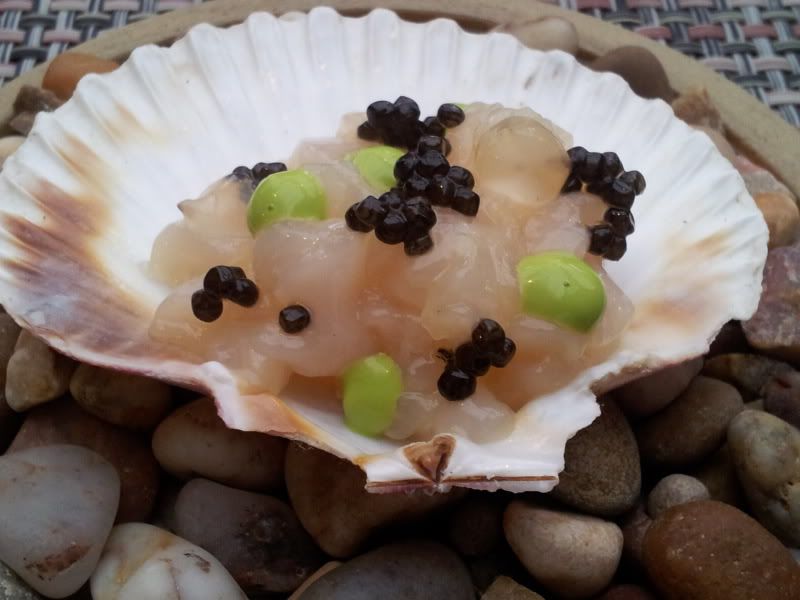 |
| Raw scallop, caviar |
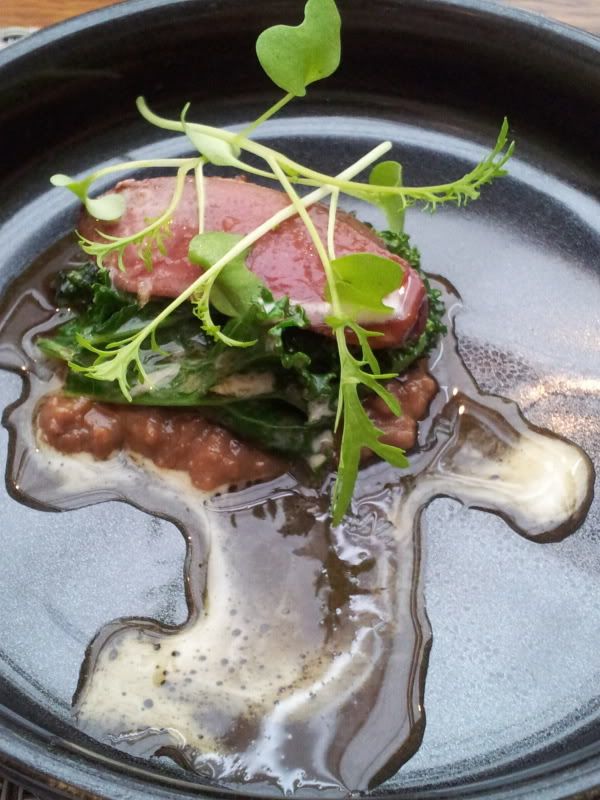 |
| Pigeon with offal ragout |
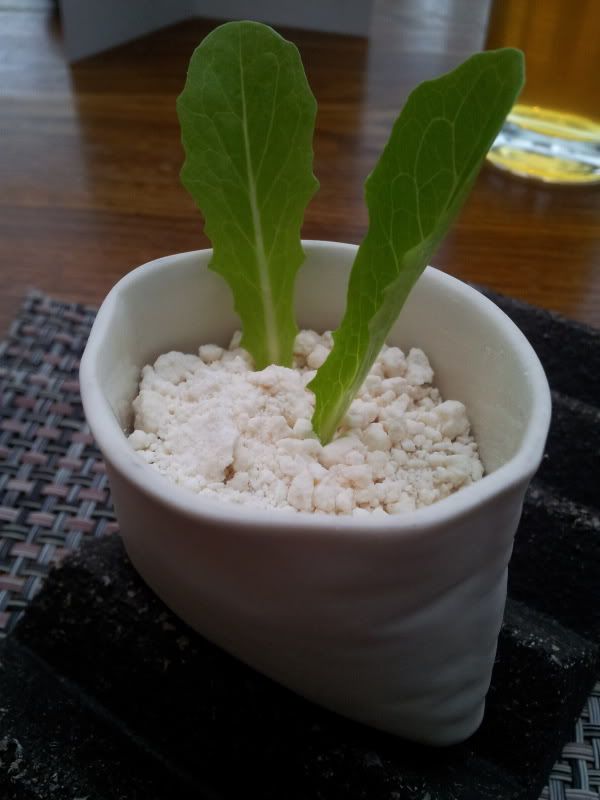 |
| Shrimp, brown bread and lettuce |
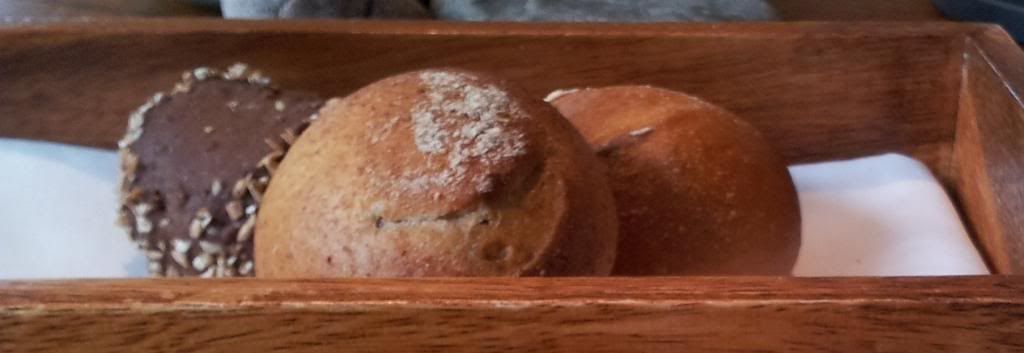 |
| Bread |
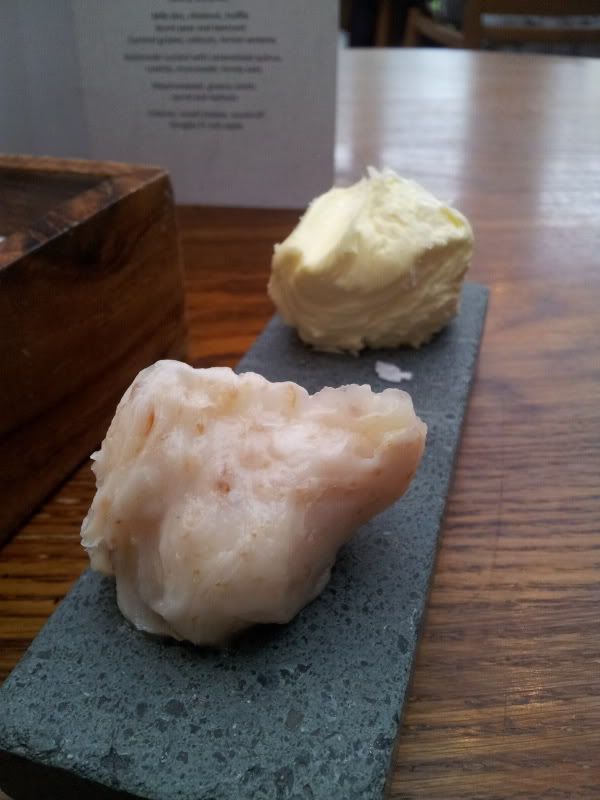 |
| Dripping and butter |
The next dish on the menu was one I've had so many times that I set the kitchen the challenge of coming up with something different. The challenge was readily accepted, and I was told the replacement dish would appear later in the meal. So this time, there was no cod 'yolk' with watercress, salt and vinegar, but here it is from a previous meal:
The cod yolk is a cod mousse encased in a gel coloured with saffron, a sort of garlic mayonnaise emulsion and puffed rice flavoured with salt and vinegar powder. Put it all together, and the flavour is not a million miles from fish and chips.
So, not having that, I moved straight onto the fabulous Westcombe dumplings: light, ultra smooth dumplings made from Westcombe Cheddar cheese, this time served with an almost beefy beetroot broth, some thinly sliced raw beetroot and a few leaves.
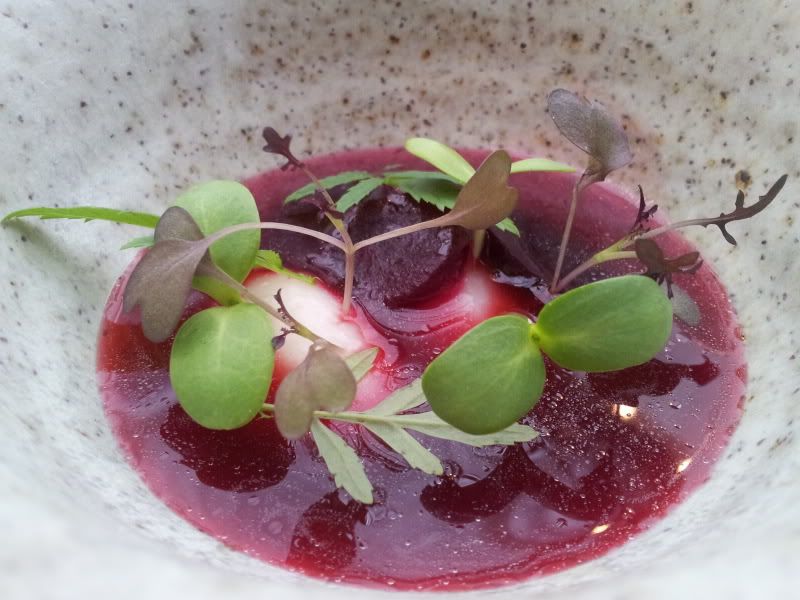 |
| Beetroot broth, westcombe dumpling and shoots |
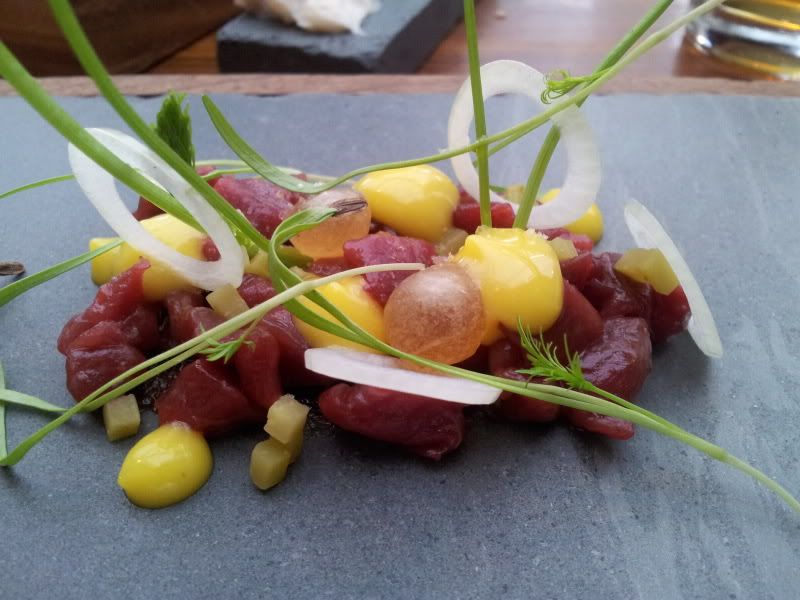 |
| Valley venison, charcoal oil, mustard and fennel |
Next came another dish where the content changes regularly, but is always driven by the crockery, which necessitates an "en deux services" approach, with the same core ingredient done in two different ways. What comes to the table is a bit like a handle-less mug with a lid. On the lid is a wafer/crisp of some description topped with some of the core ingredient in a raw form and other stuff. The waiting staff explain this, and tell you'll they'll return to explain the second part of the dish when you've eaten part one. As you can imagine, rather like the earlier sack, photographing the inside of a mug with stuff layered up inside it, is never going to be very successful, so apologies for that.
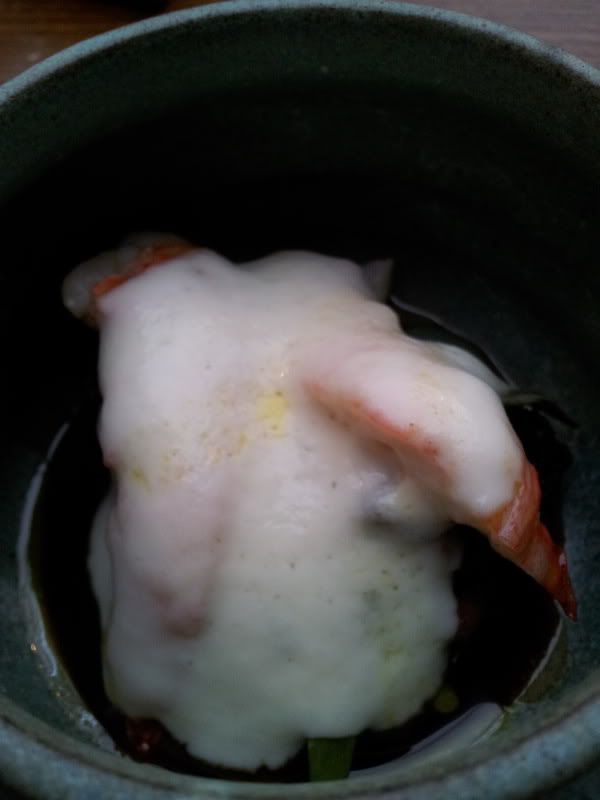 |
| Langoustine, parsnip, black pudding, hazelnut and cured yolk |
Down in the basement of this course was some impressive langoustines with a langoustine custard, a couple of cubes of a fairly soft, but underpowered black pudding. The menu tells me that parsnip came into it somewhere: perhaps the white espuma-like substance hiding everything else in the second photograph? The combination of langoustine and black pudding was good, but on balance I preferred the first stage of this dish.
Simon Rogan and his head chef, Mark Birchall, can elevate humble vegetables to the most remarkable of dishes. I remember, for example, an astonishing carrot dish three or four years ago. On this visit, potatoes were centre stage for this next dish.
 |
| Potatoes in onion ashes, lovage and wood sorrel |
Now, about two hours ago, I'd skipped a course (the cod yolk), and it was time for its replacement: sweetbreads and carrots.
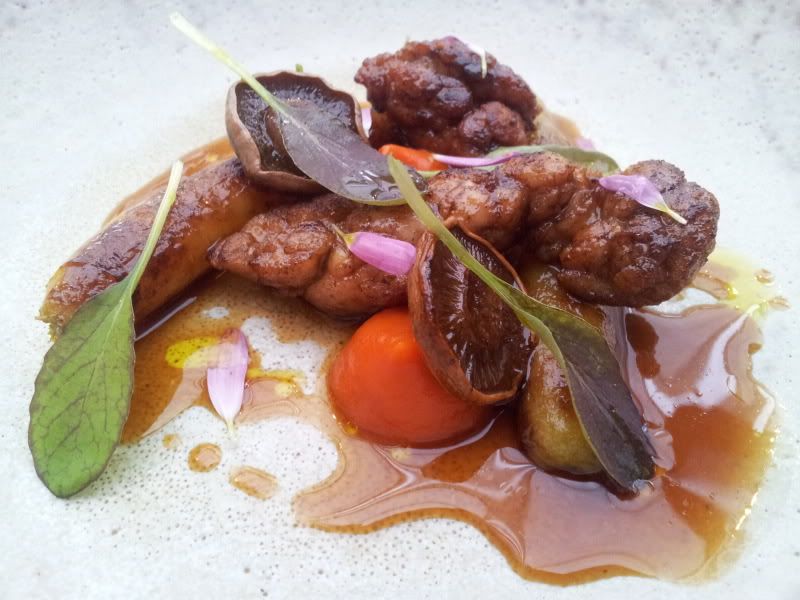 |
| Sweetbreads and carrots |
I always find the large tasting menu at L'Enclume has a nice ebb and flow throughout, eschewing traditional ideas of fish before meat and such like. So on this occasion we went from the richness of the sweetbread and carrot dish to the light delicate Dover sole dish that followed. Somehow that flow always seems to work. I suspect the often overlooked impeccable timing may have something to do with that, as the speed at which dishes come out of the kitchen and are served similarly ebbs and flows.
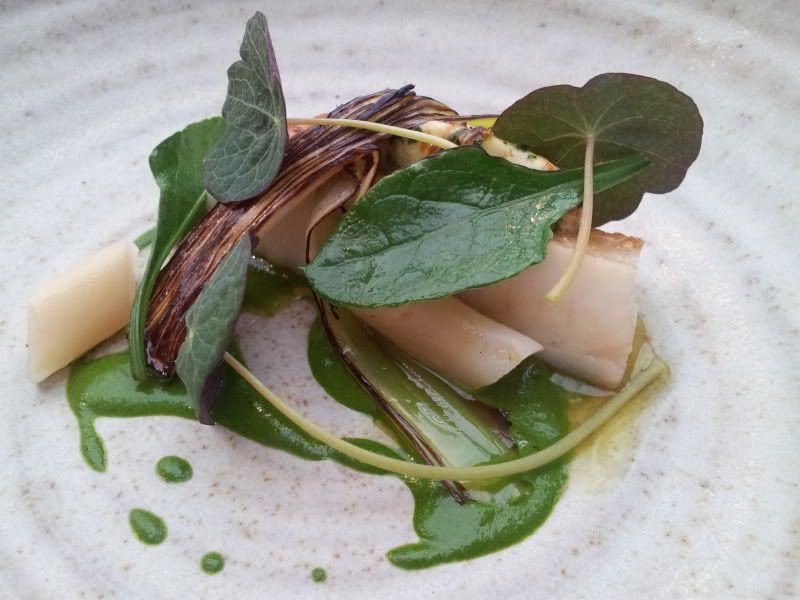 |
| Butter poached dover sole with razor clams, leeks, nasturtium butter |
The savoury part of the menu now drew to a close with a dish that didn't really need the rather impressive new cutlery.
 |
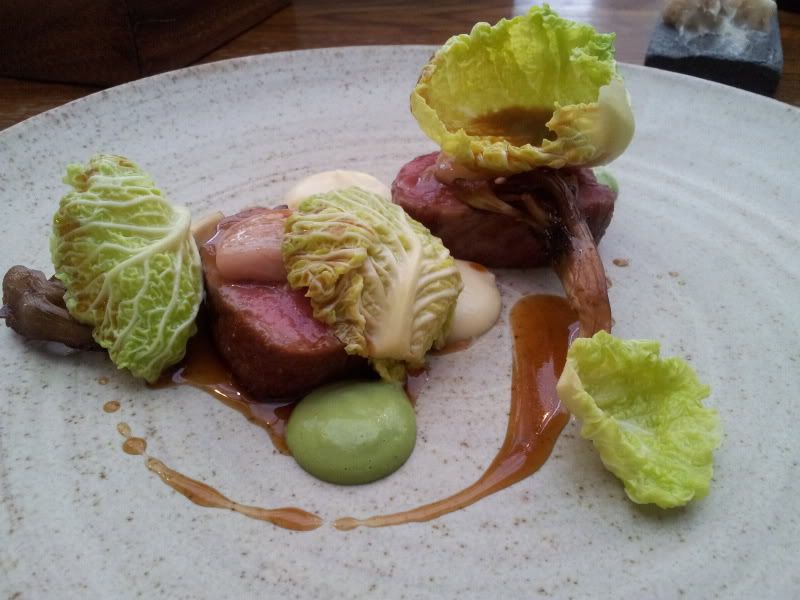 |
| Aged Dexter, cabbage, mushrooms, salsify, dittander |
Previously, we've gone straight from the main meat course to desserts. At this meal, however, there was something of a reprise of how the meal started, with a couple of small tasters.
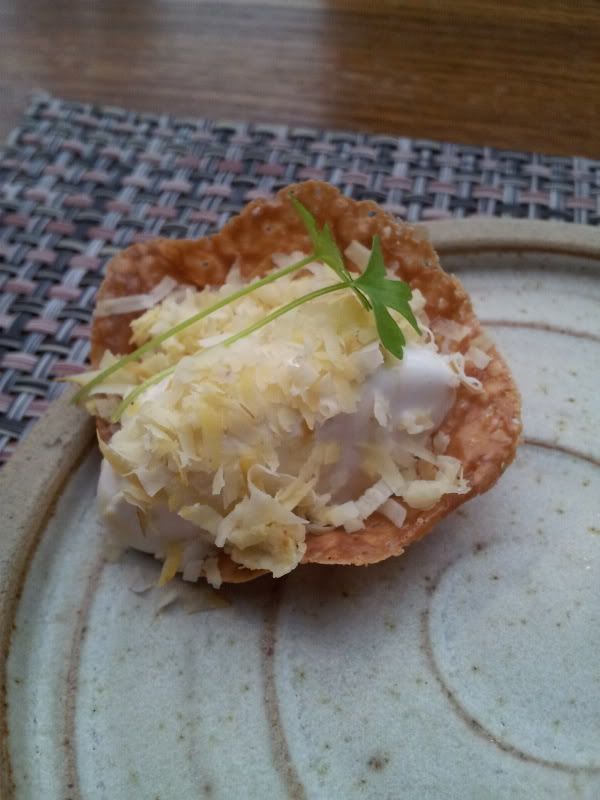 |
| Milk skin, chestnut, truffle |
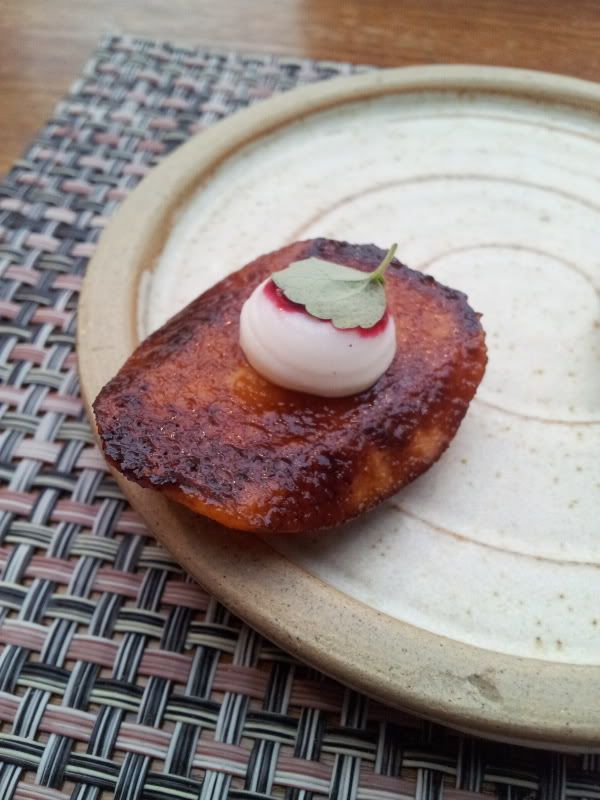 |
| Burnt pear and beetroot |
The next dish, with its slate on slate pun, I've had in a couple of guises. This time the ice-cream in the edible slate was made from grapes grown in Cartmel. Very refreshing, and also moving us onto the sweeter aspect of the menu. The lemon verbena "cake" and cobnuts worked well with it.
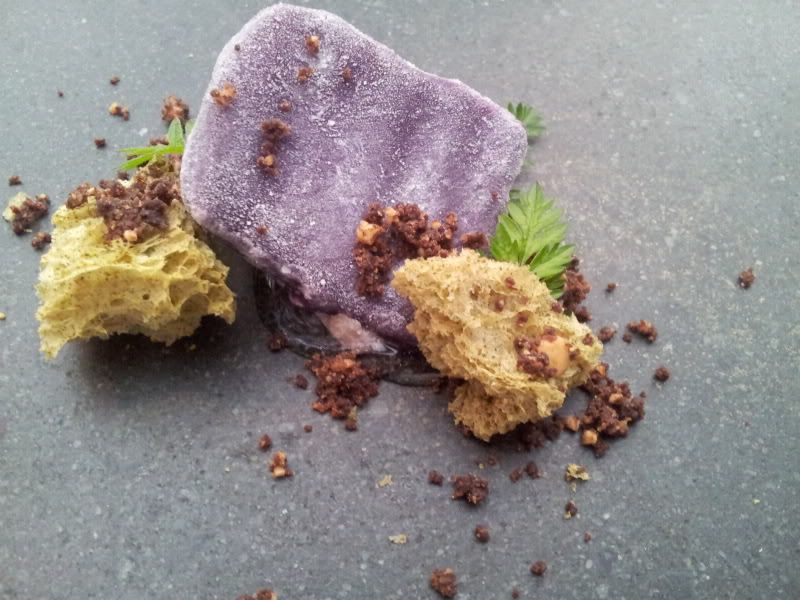 |
| Cartmel grapes, cobnuts, lemon verbena |
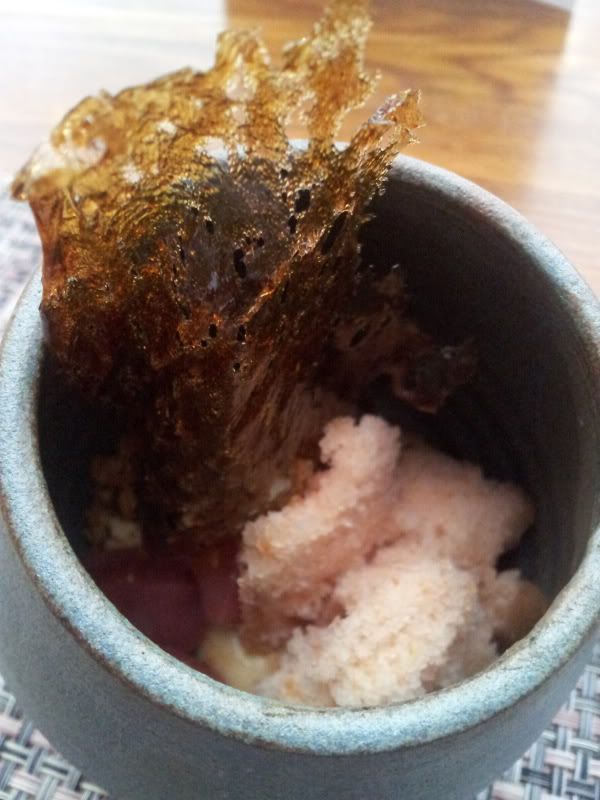 |
| Buttermilk custard with caramelised quince, rosehip, muscovado, honey oats |
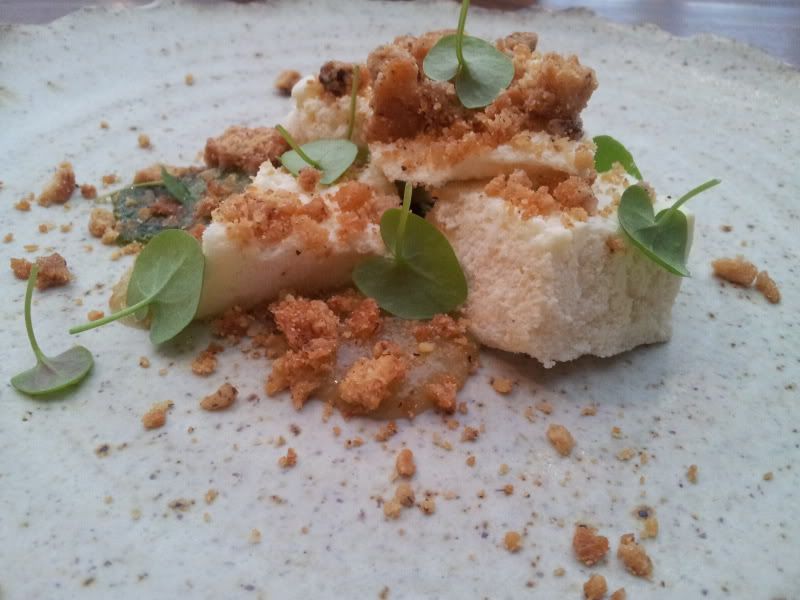 |
| Meadowsweet, granny smith, sorrel and walnuts |
Other than coffee/tea, the final things to come to the table are an empty wine glass and a large pebble into which have been drilled holes to take tiny little cornets of ice cream: on this occasion I think it was a celeriac cornet filled with celeriac ice cream, a parsnip cornet with woodruff ice cream and a raspberry (they said raspberry) cornet with a sweet cheese ice cream.
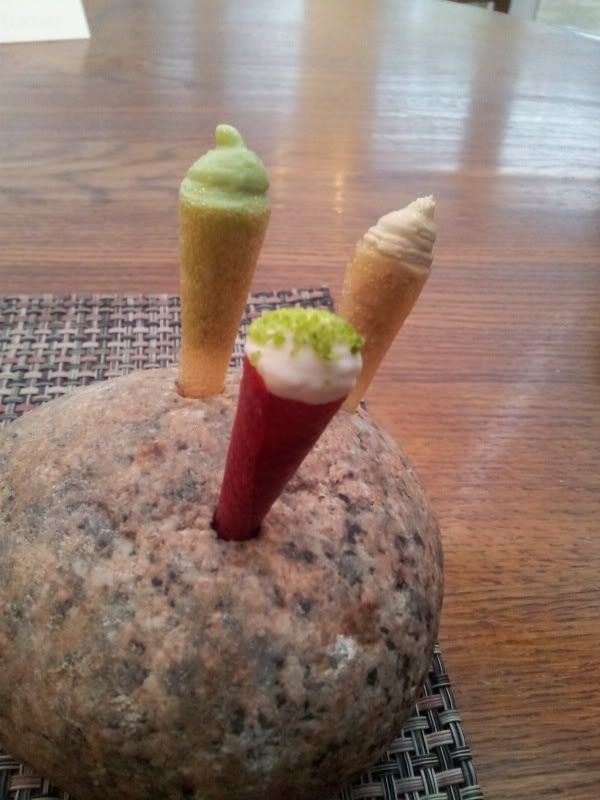 |
| Celeriac, sweet cheese, woodruff |
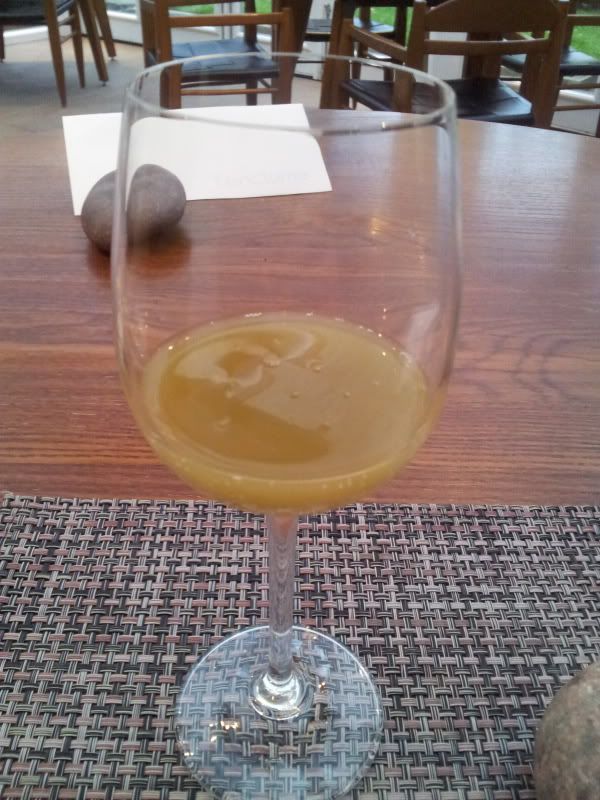 |
| Douglas fir and apple |
Coffee is always good, the herbal tea trolley is a joy to behold, as well as producing a really delicious mint based tisane. I have reservations about the petit four now, though. For at least a couple of years now the petit four has been a circle of aerated chocolate, topped with a Kendal mint cake ice cream which itself has been coated in chocolate. I expect most customers' appetites are flagging at this stage and not interested in petits fours, but - particularly compared to earlier years - it rather seems that the kitchen's interest has flagged at this stage too. This doesn't seem to quite match the ambition and constant change and search for improving on excellence that runs throughout the rest of the meal. It also marks a notable departure from the philosophy of only using British ingredients.
I think it wouldn't be inappropriate to vary the petits fours seasonally, and return to maybe the style of July 2010 (though not those black tables, please!)?
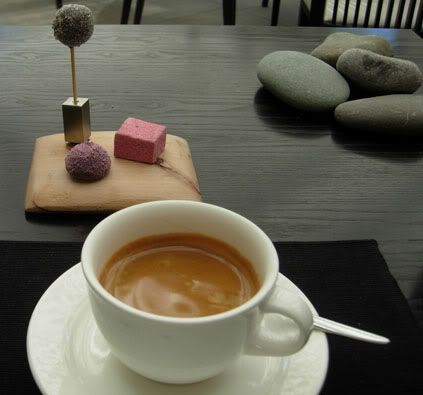 |
| L'Enclume coffee & petits fours, July 2010 |


